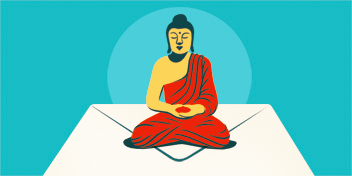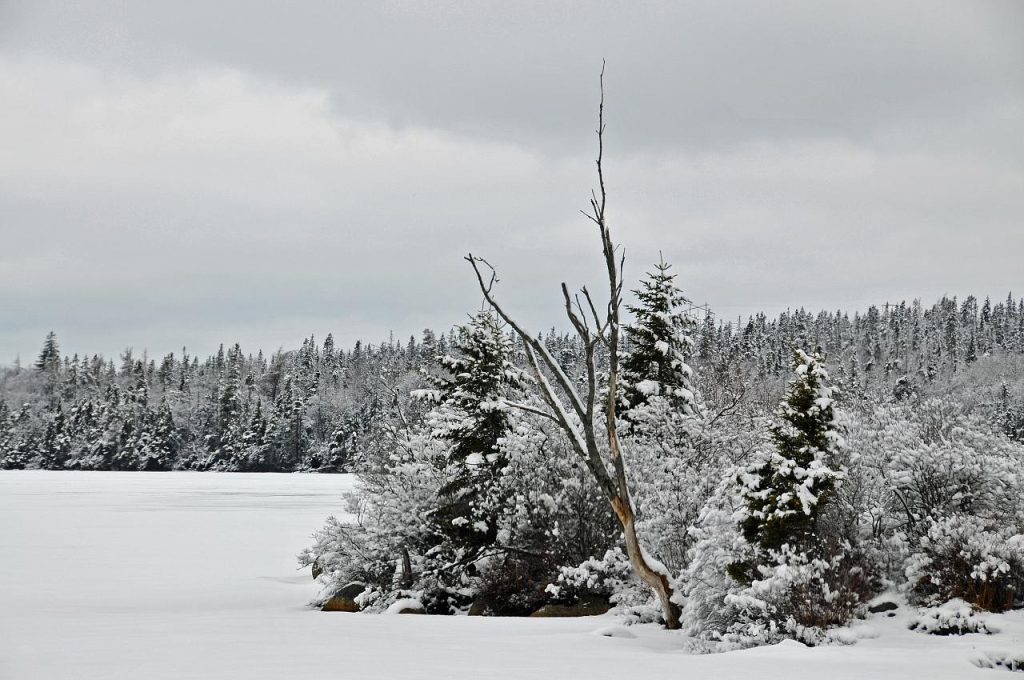I am in the middle of nowhere: a remote farmhouse at the end of a dirt road in rural Cape Breton, Nova Scotia. I drove here from New York City with a friend, arriving on March 19 with two cats, bags of lentils and grains, a cooler with frozen cooked greens, and a dozen rolls of toilet paper. The decks around the house are slick with ice. Not wanting to risk falling, I stand at the threshold of the front door for fresh air. I see the barn, encircled in ice. Inside the barn sits my car. Not a problem, as I am in quarantine; but the conditions of the dirt road, now that it’s mud season, assure that self-isolation will last long after the mandated period. The temperature fluctuates between above and below freezing, turning the mountain snows into rivulets sliding down to the sea below the house, but not before pooling up on the road with its insufficient trenches. Mud, sinkholes, and black ice often make the road impassable. Against all caution we drove to my house—not up the long, steep drive, still packed with snow, but to the bottom, and then climbed up with frightened cats and supplies, following a narrow strip of gravel cleared by a neighbor who had come in on his four-wheeler. My friend returned to New York a few days later and I settled in, safely sheltered in place.
For about ten days before leaving New York, I had responded to coronavirus news by stocking up and staying mostly separated from friends, alone in a one-room apartment in Chelsea. Even so, I went out for an hour every day, leaving by 7:00 am to walk on relatively empty streets, and saying good morning to people in my building. The isolation here in Nova Scotia is total. My feet may as well be nailed to the floor, they get so little use. But my mind roams, and frequently enough, it turns to my teacher, Mingyur Rinpoche, now in Nepal.
The intense restriction of movement has inspired reflections on Mingyur’s wandering retreat. For four and a half years he lived as a homeless yogi, having left the protections of monastic residences to wander the world, sleeping in Himalayan caves and in rural Hindu temples on the Gangetic Plain. By becoming comfortable with sheltering anywhere, he deepened his understanding of sheltering in place, and explored the more profound levels of refuge, and of coming home to oneself.
Within weeks of first setting out, Mingyur’s experiment with begging for food led to a severe intestinal infection, which brought him near death. In the fall of 2015, shortly after he returned to his monastery in Nepal, I went to visit him. At that time, he asked for my assistance in writing a book about his near-death experience and what he learned from it. He wanted to set his personal story into the larger framework of classical Tibetan teachings on living and dying, known as bardo teachings. This book was published in May 2019 as In Love with the World: A Monk’s Journey through the Bardos of Living and Dying.
In trying to figure out how to begin the book, I asked many questions about his intentions for doing a homeless retreat. I had wondered what had made this monk, raised as a dharma prince, fussed over like a hothouse orchid, give up beds, favorite foods, and hot showers. He had turned away from the privilege and prestige he had enjoyed as a brilliant dharma teacher and a somewhat precocious young abbot; he had abandoned his titles, his high seat and attendants—all for the sake of deliberately inviting discomfort, disorder, fear, uncertainty, and anonymity into his life.
Like the unwelcome intestinal infection, this lifestyle disruption also manifested the bardo cycles of death, dying and rebirth; here Mingyur was not working with the unbidden threat to his body, but with the treasured death of the ego-self. As his father, Tulku Urgyen Rinpoche, had told him many times, this aspect of our being—the conventional sense of self that is ruled by consensus and identifies with thoughts and emotions, status, and reputation—this self must die before one can be reborn into spiritual maturity. This is the death that Mingyur courted by stepping into homelessness, and into a life that no one had ever imagined for him.
Who among us has turned their lives upside down in pursuit of awakening? Who has left behind everything that is familiar and comfortable? Who walks out the door alone, no money, no food, no phone, no one to reel them in when the waters get too rough?
When the book was published, many readers expressed their dumbfounded admiration for Mingyur’s journey. And also their envy. They, too, had wanted to do something like this but…so many buts: In the US you cannot wander without starving, or freezing to death, or getting jailed for vagrancy. Or, I am a householder and have obligations to children, or to parents; or, I can offer more by staying in the world than by leaving it. And so forth. So many understandable buts.
When asked how we, as students, could disrupt the rote mindlessness that dictates so much of our day, Mingyur has answered that each of us inhabits patterns that can be broken—repetitive cycles of emotional reactivity, of eating or using substances compulsively, or unwholesome habits of speech. We have endless opportunities to explore his lessons without doing what he did. He advised us to figure out our own limits and then push against them—for instance, by increasing weights from five to ten pounds, not five to one hundred overnight. He hadn’t gone from five to a hundred, either. His disappearance into the homeless life was a giant leap, but not from five to a hundred, for he already knew the measure of his training and trusted in the capacity of his awareness to ultimately overcome the very obstacles he wished to call forth in order to strengthen his understanding.
How much did any of us truly want the degree of disruption that Mingyur arranged for himself? How often have we—myself and others I know—confessed to secret fantasies of car crashes, hiking accidents, or of illnesses that brought us close to death, not brought on by suicidal tendencies but by the longing to be reborn, to be shaken awake from complacency, and freed from layers of self-deception by a force that we cannot summon from within? Or, lacking the stamina and dedication of Bodhidharma—who sat facing a wall for nine years—we conjure a stint in jail, imagining that imprisonment would surely mobilize the quest for liberation.
And now, disruption magnified. Illness and death, impermanence and uncertainty. Fear. Panic. The world upside down. Nothing solid. The center not holding. Nothing making sense. The rug has been pulled out from under us, and our world is in free fall. My world. Can we allow ourselves to experience the dissolution, to die to what we have known, to allow our ideas of the world to die? And to be reborn in ways that we cannot envision or predict?
I do not have a television. I read headline news online, have Zoom chats, continue my daily meditations, participate in online dharma, do the practice of taking and sending [tonglen], and scroll through dozens of well-intentioned texts each day. Friends in New York barrage my phone with images, mostly of empty streets. Sometimes dogs. Everywhere the word uncertainty is uttered with mantra-like insistence, as if repetition might suck out the fear it evokes.
I hear the fear of dying; I hear the fear of hospitals, especially from friends my age, whose age alone might disqualify them for medical attention if the supplies are limited. I hear that people think that they are more afraid to die now than they were before the pandemic. I wonder if this is true. I hear that learning to live with uncertainty no longer sounds like sane advice, but like a corona curse.
What’s the alternative—sitting around praying for things to return to normal—conveniently forgetting that before the pandemic we were also afraid of uncertainty, impermanence, and death? Often enough, those fears were unacknowledged but now they are laid bare. This is the opportunity that disruption offers, like the disruption that Mingyur brought on himself by leaving home, and the disruption that came from his brush with death. Perhaps this really is an opportunity to become more comfortable with uncertainty, and more comfortable with the certainty of impermanence; and to see if we can hang in there with our fear and our panic, and allow those disturbances to shelter in place, in our bodies and minds, alongside tenderness and sadness and concern for others. To just feel them, not feed them, and to not escape into more headline news.
Ha! I imagine friends in New York saying, Easy for you to befriend uncertainty, safely sitting on your mountaintop with vast views of sky and sea. Yeah, I know. But please don’t dismiss my own need to help out. Allow me to use my fortunate situation to remember that negativity never lies in circumstances outside of ourselves—not even with a pandemic—but in how we relate to them. Would I remember this if I were still in New York City and hearing the sirens, and seeing makeshift morgues out the window, and hearing the neighbors whisper about rising vandalism and packages stolen from doorsteps? Or if I had family members on the front lines? I don’t know. Yet here I am, grateful to be here, sheltered in a place that allows the teachings to reverberate loud and true.
A young man has arrived on his four-wheeler to maneuver the car out of the barn. The snow has melted enough to get out. After four weeks inside, I am eager to drive to town to buy fresh vegetables. He leaves the car running to charge the reinstalled battery and returns to the barn to pull up the ramp and readjust the gates and doors. I step outside, giving him a smile and a thumbs-up. We have already agreed to the rules of social distancing. Across the yard, he yells, You won’t get out today. Better hope for two-three more days of dry weather.
What a letdown. Both that I could not get out and that I had so easily forgotten that nothing is certain, and that the delusion of certainty is always a setup for disappointment.
Thank you for subscribing to Tricycle! As a nonprofit, we depend on readers like you to keep Buddhist teachings and practices widely available.

